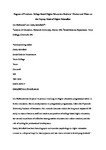Degrees of freedom: college-based higher education students’ choices and views on the top-up mode of higher education
| dc.contributor.author | McKenzie, L | en |
| dc.contributor.author | Schofield, C | en |
| dc.date.accessioned | 2018-12-03T12:52:22Z | |
| dc.date.available | 2018-12-03T12:52:22Z | |
| dc.date.issued | 2018-09 | en |
| dc.identifier.issn | 1359-6748 | en |
| dc.identifier.uri | http://hdl.handle.net/10026.1/12971 | |
| dc.description.abstract |
© 2018, © 2018 Association for Research in Post‐Compulsory Education (ARPCE). UK Higher education has for many years been offered to students at different institution types, one such being colleges of further education. He offered at further education colleges differs in many ways from that offered to a university. One way in which it differs greatly is the mode of provision. Traditional university degrees typically a commitment to a named three-year programme of study. Provision through colleges differs as students typically enrol on a two-year associate degree, which they may then decide to top up to a full bachelor’s degree at either their FEC or at partnered universities (2 + 1 mode). This research sought to investigate what factors students believed to be important when making course choices, and their reflection on the course type they chose. It was found that associate degree students tended to remain at the FEC if top-up options were available, and indicated a preference for the flexibility of the 2 + 1 mode. Factors that the majority of students deemed as important in their choice of top-up course was their career potential; students remaining at colleges were also concerned about the continuity of their educational experience and course content. | en |
| dc.format.extent | 314 - 327 | en |
| dc.language.iso | en | en |
| dc.publisher | Taylor & Francis (Routledge) | en |
| dc.title | Degrees of freedom: college-based higher education students’ choices and views on the top-up mode of higher education | en |
| dc.type | Journal Article | |
| plymouth.issue | 3 | en |
| plymouth.volume | 23 | en |
| plymouth.journal | Research in Post-Compulsory Education | en |
| dc.identifier.doi | 10.1080/13596748.2018.1490086 | en |
| plymouth.organisational-group | /Plymouth | |
| plymouth.organisational-group | /Plymouth/Faculty of Science and Engineering | |
| dcterms.dateAccepted | 2018-02-26 | en |
| dc.rights.embargodate | 2020-04-07 | en |
| dc.identifier.eissn | 1747-5112 | en |
| dc.rights.embargoperiod | Not known | en |
| rioxxterms.versionofrecord | 10.1080/13596748.2018.1490086 | en |
| rioxxterms.licenseref.uri | http://www.rioxx.net/licenses/all-rights-reserved | en |
| rioxxterms.licenseref.startdate | 2018-09 | en |
| rioxxterms.type | Journal Article/Review | en |


